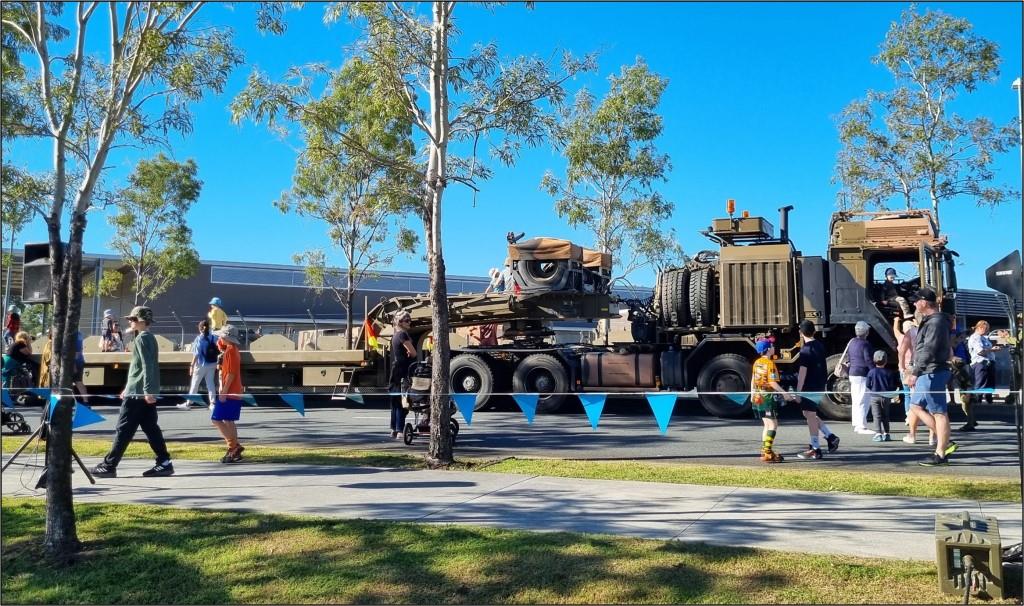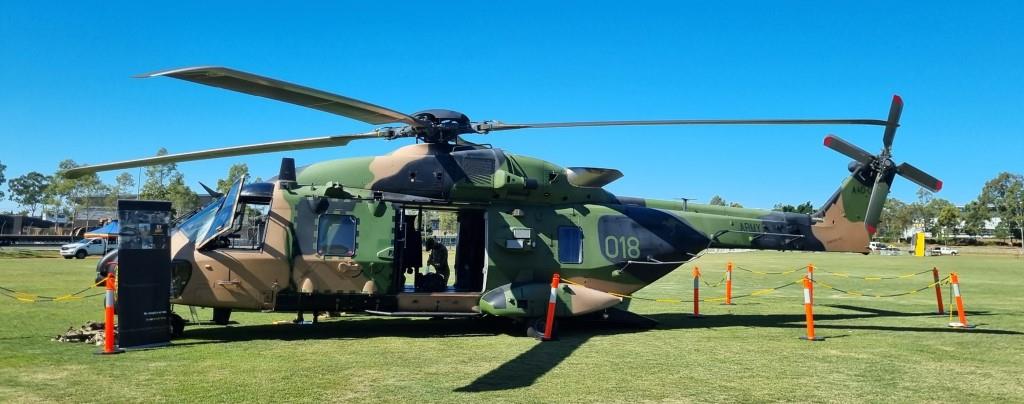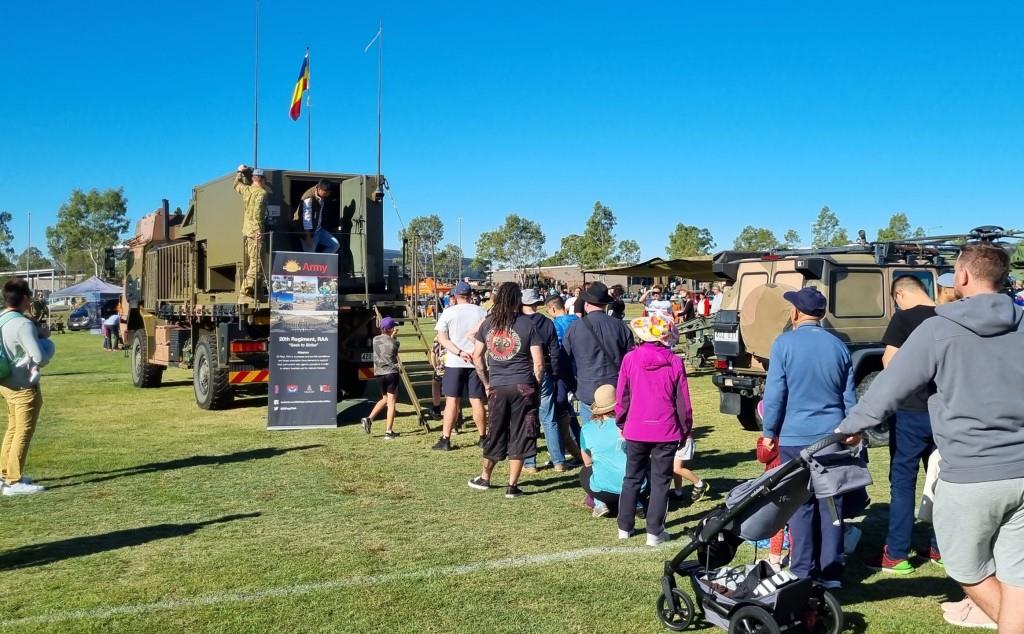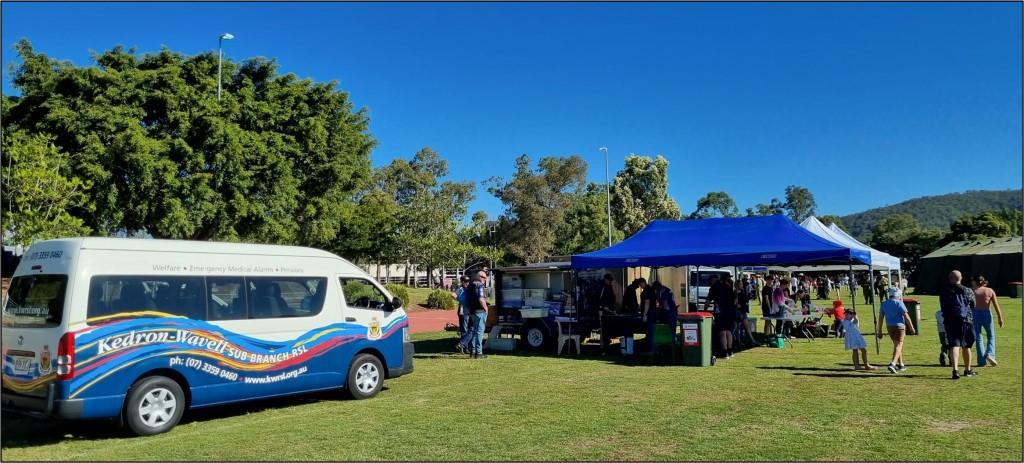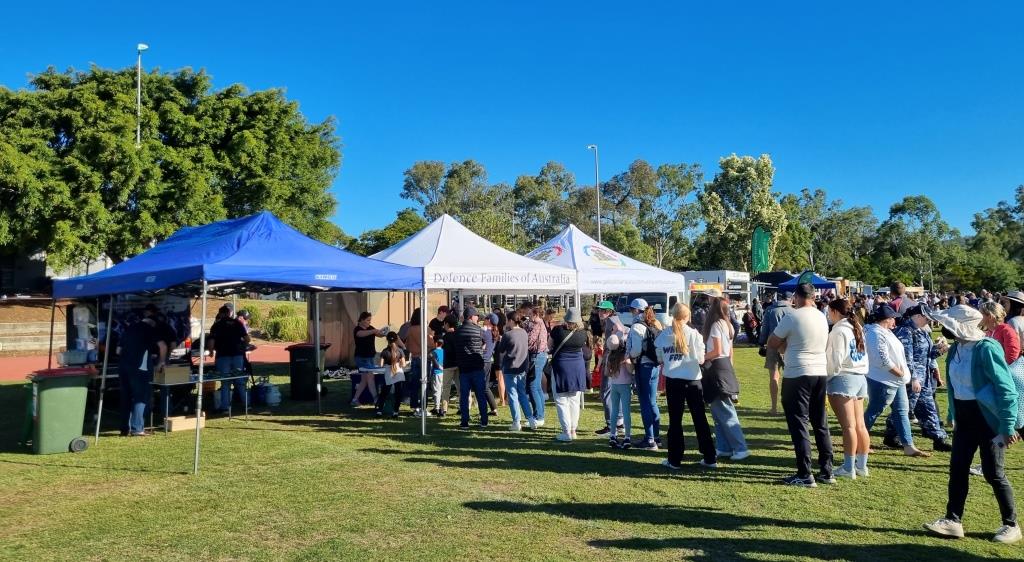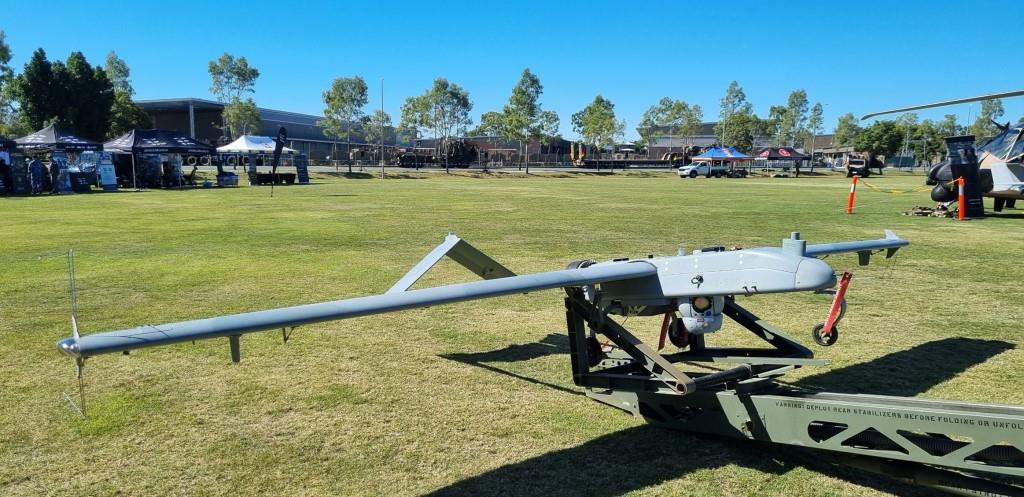
|
Vol 80 |
Page 13 |
Privacy Policy | Editorial Policy | Profit Policy | Join the Association | List of Members | Contact us | Index | Links
Back Go to page: 1 2 3 4 5 6 7 8 9 10 11 12 13 14 15 16 17 18 19 20 Forward
Contents:
Gallipoli Barracks - Open Day.
Some of the pics on this page have been crunched to allow the page to open quicker.
You can get the HD version by clicking that pic.
Gallipoli Barracks, Brisbane - Open Day!
Gallipoli Barracks Open Day, 20 May 2023, was a must do for the family.
The Gallipoli Barracks Army members are continually thankful for the support of the Brisbane community and their open day was an opportunity for them to express their appreciation. There were rides, stalls and food vendors for families to enjoy, with capability demonstrations showing the various job roles and equipment they use.
The event was also supported by music from the Australian Army Band Brisbane and if a career in the Army is something you’re considering, there was plenty of information at the open day to guide you in the right direction.
This was an alcohol-free event and as there was no parking available on the Barracks, preferred method of travel was via train to Gaythorne Station and although the event was free, tickets were required and were available online.
About 18,000 people from south-east Queensland registered to attend.
Units from across Gallipoli Barracks delighted the crowds with dynamic and static displays demonstrating Army’s capabilities. Navy and Air Force also took part with a C-27J Spartan from 35 Sqn at Amberley conducting a fly-past which proved to be a crowd favourite.
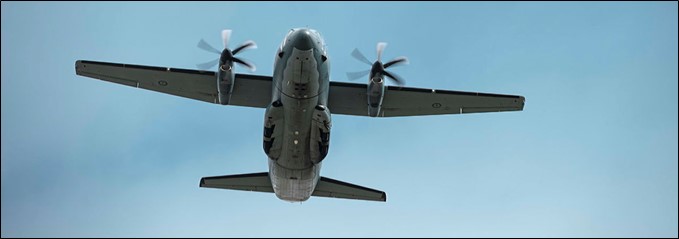
A simulated section attack from 8th/9th Battalion, The Royal Australian Regiment (8/9RAR) and Military Police dog demonstration by the 1st Military Police Battalion were also major drawcards.
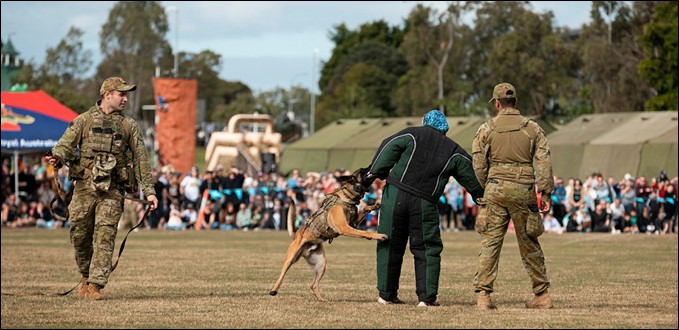
Lieutenant Nishant Khisty, 8/9RAR, said it was great to see the audience enjoying the attack display. “It got a really good reception,” he said. “I think the crowd got really stuck into it and there were plenty of cheers when we secured the enemy position, so that was great to see. It would’ve been an interesting experience for the soldiers doing it in front of so many people, but they’re all professionals and they treated it like a normal section attack.”
The departure of an Army MRH-90 Taipan late in the day also drew a huge crowd, as did the 2nd Combat Engineer Regiment explosive-device search demonstration.
The opportunity to get a close look at, or in some cases inside, military equipment was a feature of the day for many. People queued up for their turn to get up close and inside.
Boxers, ASLAVs, M1 Abrams, Bushmaster PMVs, and M113AS4 armoured personnel carriers were on show, which captured the attention of people considering a career in Defence.
Sergeant Megan Polatos, of Headquarters Australian Army Cadets, said it was a huge day for cadets in attendance, and she hoped the opportunity to get a closer look at equipment and speak to soldiers would be an educational experience. “They can put everything they are learning in cadets into perspective and think about how that would work in the Australian Defence Force or in a different career later in life. They absolutely loved it and got involved by getting on the equipment and asking a lot of questions, so it was great.”
Kedron Wavell RSL Sub-Branch was tasked with providing the barbecue lunch for the crowd – a job that kept them busy for most of the day.
One item of interest was the Army’s RQ-7B Shadow 200 drone. This drone, which was developed by the US Army, is used by the armed forces of many countries for reconnaissance, surveillance, target acquisition and battle damage assessment. It is launched from a trailer-mounted pneumatic catapult and is recovered with the aid of arresting gear similar to jets on an aircraft carrier. Its gimbal-mounted, digitally stabilized, liquid nitrogen cooled electro-optical/infrared (EO/IR) camera relays video in real time via a C-band line-of-sight data link to the ground control station.
It uses a Wankel style engine for propulsion, has a top speed of 200kph and a range of 100km. It can see targets up to 125 kilometres away from the brigade tactical operations centre and recognize tactical vehicles up to 8,000 feet above the ground at more than 3.5 kilometres slant range, day or night.
Click the pic below to see it launched.
The event ended with fireworks and a performance by the Australian Army Band.
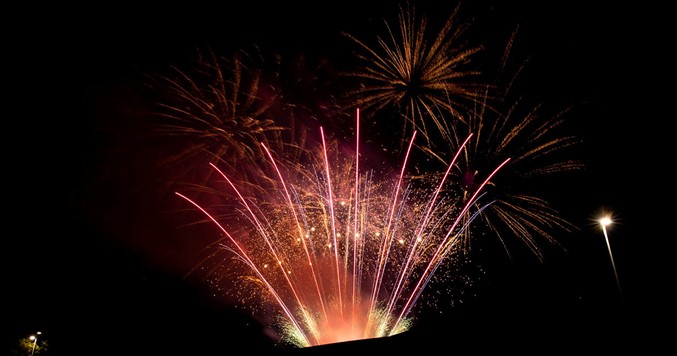
A great day – thanks Army!
Telling a woman to calm down works as well as baptizing a cat.
RAAF and evacuations from Vietnam in 1975.
The Royal Australian Air Force played a significant role in humanitarian efforts during the final days of the Vietnam War in 1975.
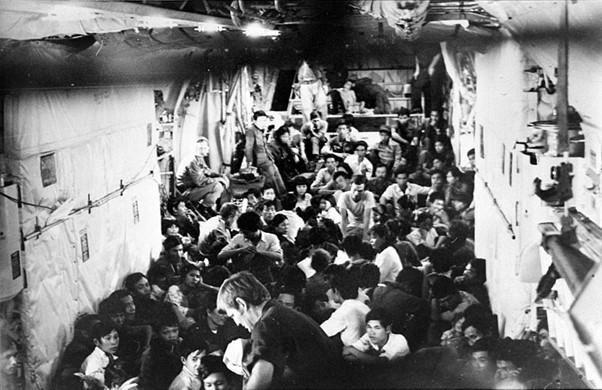
As the situation in South Vietnam deteriorated rapidly, with the North Vietnamese Army advancing towards Saigon, the RAAF helped evacuate Australian citizens and other foreign nationals from the country.
The RAAF deployed a fleet of C-130 Hercules transport planes to Saigon, which was used to fly out refugees and evacuees to safety. These planes also transported essential medical supplies, food, and water to those in need.
One notable mission carried out by the RAAF was Operation Babylift, which began on 4 April 1975. This was a massive effort to evacuate orphaned Vietnamese children and bring them to safety in Australia and other countries. The RAAF contributed several of its C-130 transport planes to the mission, flying in and out of Saigon under extremely challenging conditions.
Despite facing significant risks, the RAAF personnel involved in these humanitarian efforts worked tirelessly to ensure that as many people as possible were evacuated safely. The RAAF’s efforts in Vietnam in 1975 have been recognised as an important chapter in the organisation’s history, demonstrating the vital role that military forces can play in providing humanitarian assistance during times of crisis.
Planning and first evacuations
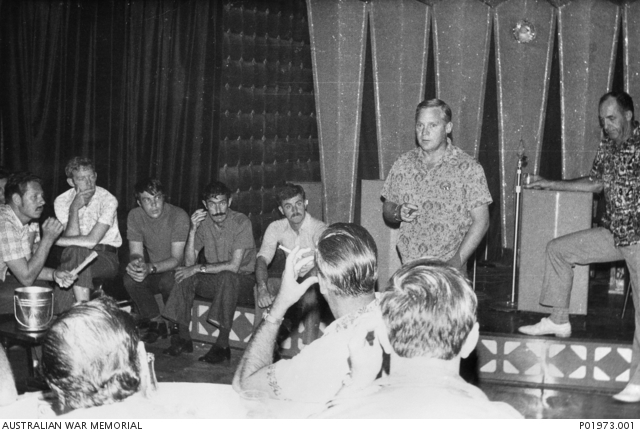
Wearing civilian clothes, Wing Commander John Mitchell briefs Detachment S’s Hercules crews in the Embassy Hotel’s ground-floor restaurant on 6 April 1975.
In his book Vietnam, Paul Ham related the story of Flying Officer Geoff Rose’s return to ‘routine operations’ after a period of heavy work during the post-Cyclone Tracy relief effort. Back at home and expecting visitors for the 1975 Easter long weekend, Rose answered a knock on his door to find instead his squadron’s navigator, Peter Gerstle, standing there with urgent news. According to Ham, Gerstle said:
“Can’t tell you where, Geoff … but pack your bags … and come to the squadron – ASAP!”
Later that day, Rose was airborne, flying in a Hercules from Richmond at the foot of the Blue Mountains to Butterworth on Malaysia’s west coast. The story of how Rose and his fellow airmen found themselves en route to Malaya began on 29 March 1975.
Facing a humanitarian crisis and imminent defeat in a war that, in one form or another, had lasted decades, the South Vietnamese Government urgently asked Australia for help. Having taken its combat troops out of Vietnam several years before, Australia responded by despatching 8 Hercules from Richmond and 2 Dakotas from Butterworth. On the ground at Butterworth, Wing Commander John Mitchell briefed his aircrews, now part of what the Air Force called ‘Headquarters Richmond, Detachment S’. The news was grim. A North Vietnamese offensive was making rapid headway. South Vietnam was on the brink.
Over a couple of days, first Da Nang, then Nha Trang and Can Ranh Bay, fell to the communists. With the ground deteriorating quickly, 2 RAAF Hercules flew into the chaos at Phan Rang to ferry refugees to Can Tho. On the tarmac, one of the aircraft was mobbed. When a salvo of rockets landed a few hundred metres away, a panicked guard, firing into the air, put his bullets through the Hercules’ tail. Nevertheless, the Australians evacuated some 1,500 refugees to Can Tho that day.
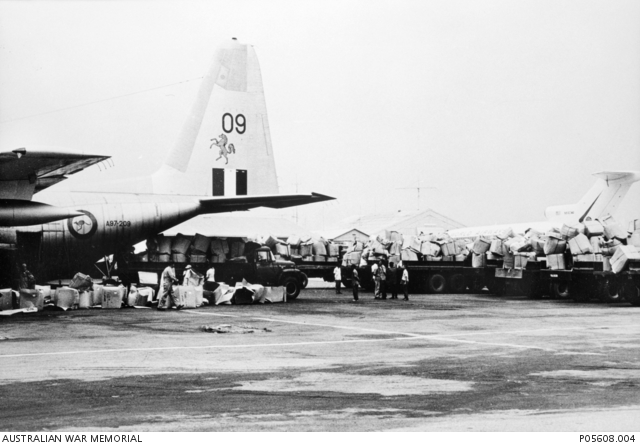
Operation Babylift
South Vietnam’s population was moving all at once. As their forebears had done in times of war, they fled an approaching enemy, seeking safety to the south and hoping for a way out. Thousands of orphans were caught in the mad rush of people vying for a means of escape. The children were far too young to appreciate the gravity of the situation. Some had been chosen for adoption in Australia, while others had homes waiting for them in the United States.
In early April 1975, the United States and Australia began evacuating the Vietnamese children in a series of flights known as Operation Babylift. On 4 April, 2 days after the United States announced Babylift, 2 Australian Hercules crews stood on the tarmac of Saigon’s Tan Son Nhut Airport chatting with a giant American Galaxy crew. After all their passengers were on board, the Americans took off, followed by the first Hercules. On the Australian plane, loaded with babies – the older ones 5 to a litter and the smallest infants in cardboard boxes on the floor, all with water bottles between their lips to ease the pain of changing air pressure – all went well, and they headed west to Bangkok.
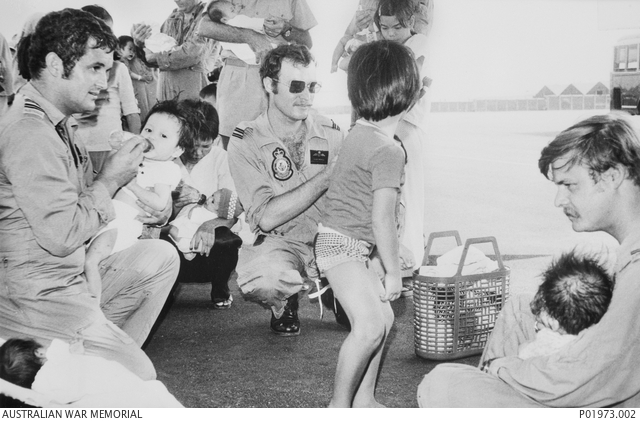
But on Galaxy, disaster struck. With 243 children, their escorts, medical staff and aircrew on board, the plane’s cargo door blew off soon after take-off. The pilots tried to return to the runway, but 2 km from the airport, the stricken aircraft hit the ground, bounced over the Saigon River and exploded. There were few survivors. The dead included 143 babies and 2 Adelaide women, Lee Makk and Margaret Moses, who had volunteered to help with the children.
A few hours later, the 2 Hercules landed at Bangkok’s Don Muang Airport and disembarked 194 children and the 3 doctors and 20 nurses who had tended the infants. Other RAAF Hercules brought some 80 Australian civilians, mostly embassy officials and their families, out of Saigon.
Life in a dangerous city.

In the South Vietnamese capital of Saigon, 100 or so Australian RAAF personnel of Detachment S lived in the relative haven of the Embassy Hotel, just 150 m from the Presidential Palace. Around them, social order was collapsing. On 8 April, an Australian crew waiting to land at Tan Son Nhut noticed a South Vietnamese F-5 flying low over Saigon and wondered what the pilot was doing. At the same time, on the ground, the RAAF contingent’s senior officer, Group Captain Lyall Klaffer (right), was walking between the Embassy Hotel and the Caravelle Hotel, which was home to the Australian Embassy, when he heard machine guns and the roar of a low flying jet. He looked up in time to see 2 high explosive bombs dropping from the aircraft onto the Presidential Palace.
At the Embassy Hotel, broken glass showered Australian aircrew as they were eating breakfast. The jet’s pilot is believed to have landed his plane on a North Vietnamese airfield. At around the same time, some of the RAAF personnel were threatened at gunpoint by a South Vietnamese officer who made it clear that if he couldn’t get out of Vietnam, neither could anyone else. The risk of sabotage seemed all too real and in any case, the enemy was drawing nearer. On 14 April, shells ignited the Bien Hoa airbase’s bomb storage area in a massive explosion just 30 km from Saigon.
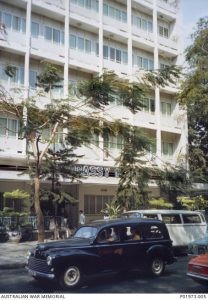
No longer safe in South Vietnam’s capital, the Australians decamped for Bangkok where they took up residence in the Sheraton and Montien hotels, flying into Tan Son Nhut each day to carry out operations and returning to Bangkok in the evening.
The end in Vietnam.
More orphans were flown out on 17 April, ending that part of the operation but the Australian airmen remained to carry out airlifts coordinated by the United States Aid Organisation. The Australians were joined by a detachment of Royal New Zealand Air Force personnel flying Bristol Freighters and later C-130s. Together, as they flew emergency food, medical and other relief supplies to some 40,000 refugees now crowded into a former POW camp at An Thoi on Phu Quoc island, they witnessed the Vietnam War’s dying days in all its bloody confusion.
Rockets hit the airfield, and some RAAF personnel saw 30 mutinous South Vietnamese marines executed. Don Muang Airport, a combined civilian-military airport to the north of Bangkok, was a hive of activity as humanitarian agencies stockpiled relief supplies for transport to Saigon. Working on the civilian side of the airport in the stifling Bangkok heat, in the sweltering cargo bays of their aircraft, the Australian crews started exhibiting signs of heat exhaustion. Soon they were moved to the military side of the airport, where better facilities eased their task a little.
On Anzac Day 1975, the last 3 RAAF flights landed in Saigon. The war was entering its final days. Just before 7 o’clock that evening, the Australian Ambassador Geoffrey Price and the last 10 of his Australian staff members were brought out of South Vietnam, along with 15 Vietnamese refugees and 9 Australian journalists. Earlier flights carried out a small group of orphans and 34 Vietnamese nuns.
Left behind were some 130 Vietnamese who had the approval to be flown out, along with another 30 former employees of the Australian Embassy. Loyal staff who had served Australia for years were left to their fate.
Last to leave
The last Australian military personnel to leave Vietnam, 13 years after the first had arrived, were 4 Air Defence Guards:
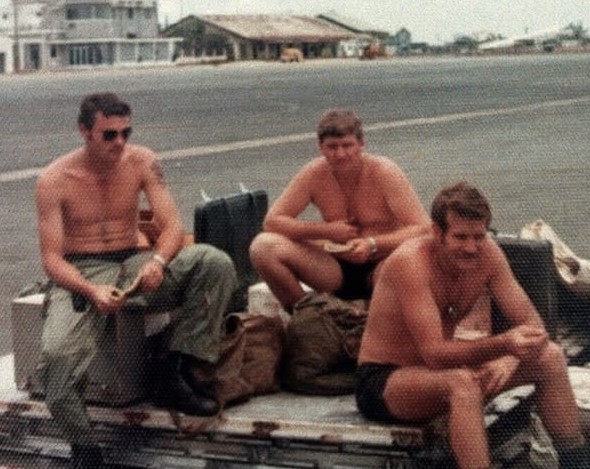
|
Sergeant John Hansen |
Corporal Ian Dainer |
|
Leading Aircraftman Trevor Nye |
Leading Aircraftman Mick Sheean. |
Left behind when the last evacuation aircraft took off from Tan Son Nhut, they had neither support, supplies nor means of communication. Carrying a pistol and 4 rounds of ammunition each, they had no idea how long it might be before rescue came. Meanwhile, the din of gunfire and rocket explosions around the airport grew louder and the North Vietnamese drew nearer. Of more immediate concern, perhaps, was the threat from South Vietnamese personnel facing imminent defeat and a deeply uncertain future.
None of the 4 RAAF personnel could be sure that these soldiers, feeling deserted by their allies, nearly all of whom had now fled the communist onslaught, would not turn on them in these final desperate hours. Fortunately, a Hercules had been detailed to circle off South Vietnam’s coast to collect anyone who had been left behind. The relief felt by the 4 Australians when the RAAF transport came into view can only be imagined.
More than 200 people – air and ground crew, equipment and administration personnel, nurses and other medical staff – flew on operations during the RAAF’s final involvement in the Vietnam War. Some flew into the Laotian capital, Vientiane. Like Cambodia, Laos had been dragged into the war only to share in a crushing defeat.
By the end of April 1975, the 3 countries which had compromised the territory of the former French Indochina – Vietnam, Laos and Cambodia – were under communist control.
When I get a headache I take two aspirin and keep away from children just like the bottle says.
